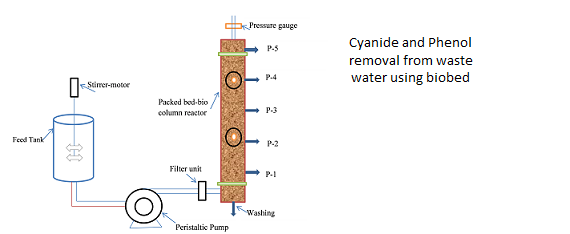
Simultaneous treatment of phenol and cyanide containing synthetic/simulated wastewater using mixed culture immobilized on coconut shell activated carbon biomass in a packed bed bio-column reactor
Abstract
Keywords
Full Text:
PDFReferences
G. Busca, S.Berardinelli, C.Resini, L. Arrighi. Technologies for the removal of phenol from fluid streams: A short review of recent developments. J. Hazard. Mater. 2008, 160, 265–288.
R.R. Dash, C.Balomajumder. Arvind Kumar Removal of cyanide from water and wastewater using granular activated carbon. Chem. Eng. J. 2009,146, 408–413.
Z. Aksu, J. Yener. A comparative adsorption/biosorption study of mono-chlorinated phenols onto various sorbents. Waste Manage. 2001, 21, 695–702.
J.D.Desai,C.Ramakrishna. Microbial degradation of cyanides and its commercial application. J.Sci. Ind. Res. 1998, 57, 441-453.
K. Juttner, U. Galla, H. Schmieder. Electrochemical approaches to environmental problems in the process industry. Electrochim. Acta. 2000, 45, 2575–2594.
M. Tomaszewska, S. Mozia,W. Morawski. Removal of organic matter by coagulation enhanced with adsorption on PAC. Desalination. 2004, 162, 79–87.
Z. Lazarova, S. Boyadzhieva. Treatment of phenol-containing aqueous solutions by membrane-based solvent extraction in coupled ultrafiltration modules. J. Chem. Eng. 2004, 100, 129–138.
W. Kujawski, A. Warszawski, W. Ratajczak, T. Porebski, W. Capala. Removal of phenol from wastewater by different separation techniques. Desalination. 2004, 163, 287–296.
S.A.K. Palmer, M.A. Breton, T.J. Nunno, D.M. Sullivan, N.F. Surprenant. Technical Resource Document: Treatment Technologies for Metal/Cyanide-Containing Wastes. Volume III, US EPA Rept. No. EPA-60O/S2-87/106, 1988.
M.M.Botz. Overview of cyanide treatment methods,in: Mining Environmental Management, Min. J. Ltd., London, UK, 2001.
R.R. Dash, A. Gaur ,C. Balomajumder. Cyanide in industrial wastewaters and its removal: A review on biotreatment. J. Hazard. Mater. 2009, 163, 1–11.
H. S. Lee and J. H. Suh. Continuous Biosorption of Heavy Metal Ions by Ca-loaded Laminaria japonica in Fixed Bed Column. Korean J. Chem. Eng. 2000, 4, 477.
Z Aksu, F. Gönen. Binary biosorption of phenol and chromium (VI) onto immobilized activated sludge in a packed bed: prediction of kinetic parameters and breakthrough curves. Sep. Purif. Technol.2006,49,205–216.
N. Singh, C. Balomajumder. Simultaneous biosorption and bioaccumulation of phenol and cyanide using coconut shell activated carbon immobilized Pseudomonas putida (MTCC 1194). J. Environ. Chem. Eng. 2016, 4, 1604–1614.
A.Akcil, A.G. Karahan, H. Ciftci, O. Sagdic. Biological treatment of cyanide by natural isolated bacteria (Pseudomonas sp.). Min. Engg. 2003, 16, 643–649.
M.M. Figueira, V.S.T. Ciminellei, M.C. deAndrade, V.R. Linardi. Cyanide degradation by an Escherichia coli strai. Cana. J. Microbio. 1996, 42, 519–523.
I. Finnegan, S. Toerien, L. Abbot, F. Smith, H.G.Raubenheimer. Identification and characterization of an Acinetobacter sp. capable of assimilation of a range of cyano-metal complexes. Free cyanide ions, and simple organic nitriles. App.Micro. Biotech. 1991, 36,142–144.
P.R. Meyers, P. Gohool, D.E. Rawling, D.R. Wood. An efficient cyanide degrading Bacillus pumilus strain. J.Gen. Microb. 1991,137,1397–1400.
G. Gurujeyalakshmi and P. Oriel. Isolation of phenol-degrading Bacillus stearothermophilus and partial characterization of the phenol hydroxylase. Appl. Environ. Microbiol. 1989, 55, 500.
P. J. Allsop, Y. Chisti, M. M. Young and G.R. Sullivan. Dynamics of phenol degradation byPseudomonas putida. Biotechnol. Bioeng. 1993, 41, 572.
L. G. Torres, A. Sanchez-de-la-Vega, N.A. Beltran, and B.E. Jimenez. Production and characterization of a Ca-alginate biocatalyst for removal of phenol and chlorophenols from wastewaters. Process Biochem. 1998, 33, 625-634.
O. J. Hao, M. H. Kim, E. A. Seagren and H. Kim. Kinetics of phenol and chlorophenol utilization by Acinetobacter species. Chemosph. 2002, 46, 797.
P. Mondal, C. B. Majumder and B. Mohanty. Treatment of arsenic contaminated water in a laboratory scale up-flow bio-column reactor. J. Hazard. Mater. 2008, 153,136-145.
J. C. Brown, V. L. Snoeyink, and M. J. Kirisits. Abiotic and biotic perchlorate removal in an activated filter. J. Am. Water Works Assoc. 2002,94,70–79.
P. Laurent, A. Kihn, A. Andersson, and P. Servais. Impact of backwashing on nitrification in the biological activated carbon filters used in drinking water treatment. Environ. Technol. 2003, 24, 277–287.
G. Nakhla and S. Farooq. Simultaneous nitrification-denitrification in slow sand filters. J. Hazard. Mater. 2003, 96, 291–303.
MTCC Guide lines, http://www.imtech.res.in/mtcc/bacteria.htm.
B. Agrawal, and C.Balomajumder. Coke waste water: A source of phenol and cyanide assimilating bacteria. J. of Sci. Tech. Manegement, 2012, 5(1).
N. Singh, B. Agarwal, C.Balomajumder. Simultaneous treatment of phenol and cyanide containing aqueous solution by adsorption, biotreatment and simultaneous adsorption and biotreatment (SAB) process. J. Environ. Chem. Eng. 2016,4, 564–575.
M.H. El-Naas, S. Al-Zuhair, S. Makhlouf. Continuous biodegradation of phenol in a spouted bed bioreactor (SBBR). Chem. Eng.J. 2010,160,565-570.
T. Jong, D.L. Pany. Removal of sulfate and heavy metals by sulfate reducing bacteria in short term bench scale up-flow anaerobic packed bed reactor runs. Water Res. 2003, 37, 3379–3389.
I. Katsoyiannis, A. Zouboulis, H. Althof, H. Bartel. Arsenic removal from ground waters using fixed bed up flow bioreactor.Chemosphere. 2002,47, 325–332.
 ISSN 2321-4635
ISSN 2321-4635